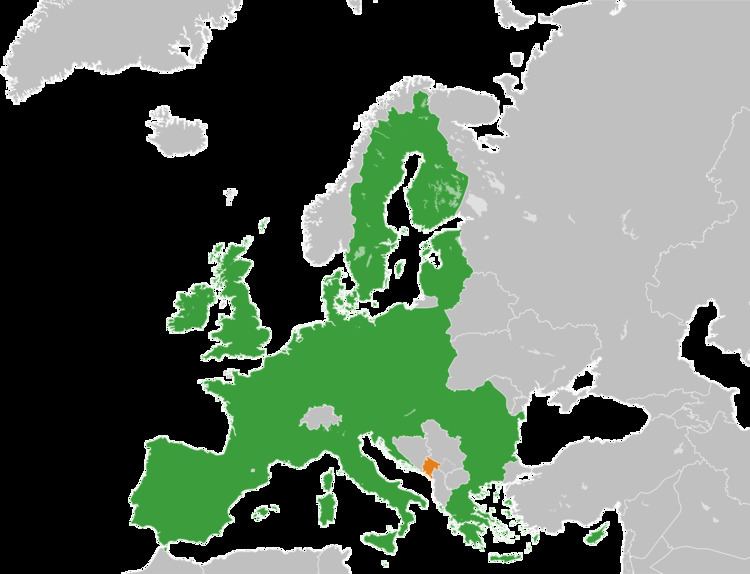Status Negotiating Closed chapters 2 | Opened chapters 26 552,780 7,157 | |
 | ||
Website Montenegrin MFAEI websiteDelegation of EU to MontenegroEU Commission website 40,600 {{{national_gdp_ppp_per_capita}}} | ||
The State Union of Serbia and Montenegro started the process of Accession to the European Union in November 2005, when negotiations over a Stabilisation and Association Agreement began. In May 2006, Montenegro voted for independence in a referendum and the State Union of Serbia and Montenegro was dissolved. Serbia continued with the existing negotiations, and separate negotiations were launched with Montenegro in September 2006. The Agreement was initialled on 15 March 2007 and officially signed on 15 October 2007. In 2010, the Commission issued a favourable opinion on Montenegro's application, identifying 7 key priorities that would need to be addressed for negotiations to begin, and the Council granted it candidate status. In December 2011, the Council launched the accession process with a view to opening negotiations in June 2012. The accession negotiations with Montenegro started on 29 June 2012. With more than two thirds of the accession chapters opened, the country enjoys a widespread support among EU members' officials and is expected to conclude negotiations by 2019. In its 2016 assessment of the accession progress, European Commission has identified Montenegro as having the highest level of preparation for membership among the negotiating states.
Contents
Application
Montenegro officially applied to join the EU on 15 December 2008. On 23 April 2009, the Council invited the European Commission to submit its opinion on the application. The Commission presented Montenegro with a questionnaire to assess its application on 22 July 2009. On 9 December 2009, Montenegro delivered its answers to the EC questionnaire. On 1 May 2010, the Stabilisation and Association Agreement (SAA) between Montenegro and the European Union came into force, after all the 27 member-states of EU had ratified the SAA. The European Commission on 9 November 2010 recommended Montenegro as candidate country. This candidate status was officially granted on 17 December 2010.
Montenegro is experiencing ecological, judicial and crime-related problems that may hinder its bid. Montenegro signed an agreement with the Bulgarian government in December 2007 in which Bulgaria will assist Montenegro with its Euro-Atlantic and EU integration for the following three years.
On 27 July 2010, the Montenegrin Parliament passed a non-discrimination law that includes sexual orientation and gender identity as prohibited grounds of discrimination. This was one of the requirements the country had to meet for EU membership.
Montenegro's population is overwhelmingly pro-EU, with 76.2% being in favour according to polling and only 9.8% against, in October 2009.
To work on these matter the Ministry of Foreign Affairs and European Integration of Montenegro has a special agency dedicated to accession to the EU, the Office for assistance to the Chief Negotiator. The goal of the office is to support the task of the Chief Negotiator for Montenegro’s Accession to EU, Aleksandar Andrija Pejović.
Unilateral euro adoption
Montenegro has no currency of its own. As a constituent republic of the Socialist Federal Republic of Yugoslavia following World War II, and later of the Federal Republic of Yugoslavia, the Yugoslav dinar was the official currency in Montenegro. In November 1999, the government of Montenegro unilaterally designated the Deutsche Mark as its co-official currency with the dinar, and on 1 January 2001 the dinar officially ceased to be a legal tender in Montenegro. When the euro was introduced and the Deutsche Mark yielded, Montenegro followed suit and began using the euro as well without any objections from the European Central Bank (ECB). The European Commission and the ECB have since voiced their discontent over Montenegro's unilateral use of the euro on several occasions.” A statement attached to their Stabilisation and Association Agreement with the EU read: "unilateral introduction of the euro was not compatible with the Treaty." The EU insists on the strict adherence to convergence criteria (such as spending at least 2 years in the ERMII system) which are not negotiable before euro adoption, but have not intervened to stop the unilateral adoption of the euro by Montenegro in 2002.
The issue is expected to be resolved through the negotiations process. The ECB has stated that the implications of unilateral euro adoption "would be spelled out at the latest in the event of possible negotiations on EU accession." Diplomats have suggested that it's unlikely Montenegro will be forced to withdraw the euro from circulation in their country. Radoje Žugić, Montenegro's Minister of Finance, has stated that "it would be extremely economically irrational to return to our own currency and then later to again go back to the euro." Instead, he hopes that Montenegro will be permitted to keep the euro and has promised "the government of Montenegro, will adopt some certain elements, which should fulfil the conditions for further use of the euro; such as adopting fiscal rules."
Visa liberalisation process
On 1 January 2008 the visa facilitation and readmission agreements between Montenegro and the EU entered into force. Montenegro was added to the list of visa exempt nationals on 19 December 2009, allowing their citizens to enter the Schengen Area, Bulgaria, Cyprus and Romania without a visa when traveling with biometric passports. Visa liberalisation process does not include travels to Ireland or the United Kingdom as these countries operate their own respective visa regimes outside of the Schengen Agreement.
